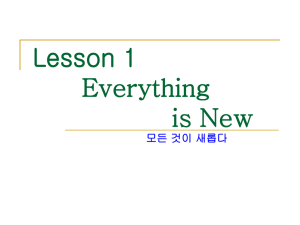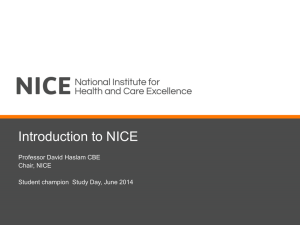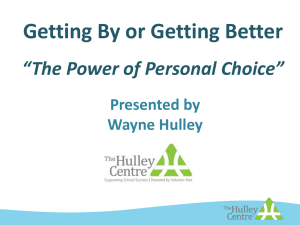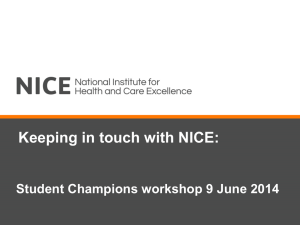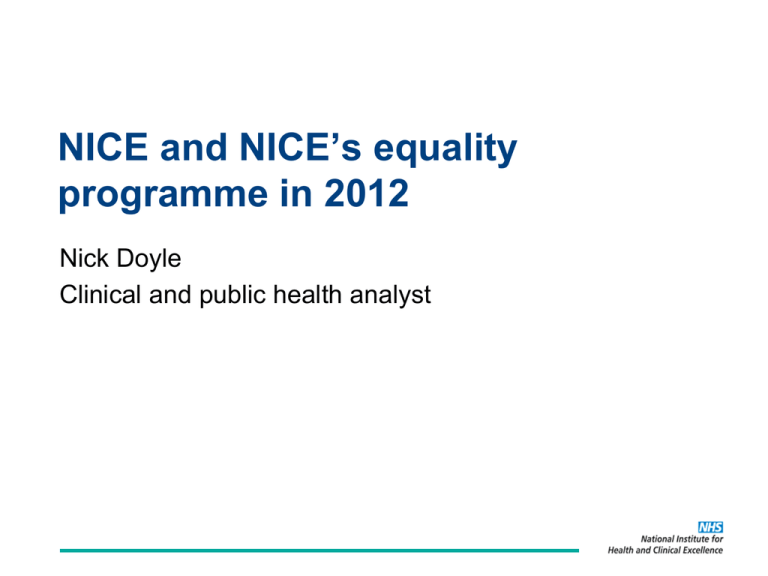
NICE and NICE’s equality
programme in 2012
Nick Doyle
Clinical and public health analyst
Ground to be covered
• About NICE
• Where NICE fits into the health, public health, and social care
system
• NICE’s approach to equality analysis
• Developments since the last Equality Forum
• The impact of our equality analyses on guidance recommendations
• NICE’s equality objectives
• Our priorities for 2013/2014
What does NICE do?
• NICE provides guidance on promoting good health and preventing
and treating ill health
• NICE guidance is about:
–
–
–
–
Clinical practice (clinical care for diseases and conditions)
Public health (preventing disease and improving the population’s health)
Health technologies (drugs and other treatments)
Interventional procedures, medical devices and diagnostic tools
• But it also includes:
–
–
–
Quality standards for the NHS, social care, and public health
Quality and Outcomes Framework (QOF) indicators for primary care
Commissioning outcomes framework (COF) indicators for measuring
the impact of commissioning by clinical commissioning groups
• NICE runs:
–
–
NHS Evidence, giving Google-like access to high quality evidence
The Medicines and Prescribing Centre (MPC), providing NICE good
practice guidance on use of medicines
NICE in the health and social care system
Cabinet Sub-Committee
on Public Health
Dept for Education
Dept for Communities
Dept for Transport etc
Ofsted
Central
Secretary of State for
Health
Department of Health
Public Health
England
NICE
Health &
wellbeing
boards
Local
Local authorities
adult/children’s social care,
public health, housing,
transport, environment etc
Housing, transport,
environment, leisure etc
Social
care
Public
health
Community
health services
NHS Commissioning
Board
CQC
Clinical
commissioning
groups
NHS
healthcare
Some public
health
Primary
care
NICE’s approach to equality analysis
Equality and
diversity
•Age
•Disability
•Gender reassignment
•Pregnancy &
maternity
•Race
•Religion or
belief
•Sex
•Sexual
orientation
People
sharing
protected
characteristics
Health inequalities
and inequity
Socio-economic
Special
groups
•Social
exclusion
•Area-based
deprivation
•Determinants
of health
inequalities
For example:
•Homeless people
•Looked after
children
•Asylum seekers
NICE’s equality analysis process
Characteristic
Y
N
age
disability
Scoping
gender
reassignment
pregnancy
and maternity
race
Assessing the
evidence
religion or
belief
sex
sexual
orientation
Draft guidance, quality
standard or indicator
socioeconomic
other
Final guidance
Involvement of
stakeholder
organisations
Involvement of
patients, carers
and the public
Developments since the last Equality Forum
• NICE’s annual equality report:
–
–
–
Compares the diversity of NICE’s workforce and advisory bodies with
that of other organisations – the Department of Health, the CQC, the
EHRC, and health, social care and ‘other’ public bodies
finds a smaller proportion of people describing themselves as disabled
among NICE staff and new members of NICE advisory bodies than in
the ‘benchmark’ organisations
finds a marked rise in rates of non-disclosure of monitoring information
among new members of NICE advisory bodies
• NICE’s equality objectives – focusing on diverse advisory body
membership and effective participation
• Our response to the 2011 Equality Forum’s suggestions:
–
–
An immediate change – we now consult at the scoping stage of NICE
quality standards
A number of areas for longer-term development
• Patient and Public Involvement Programme project on engagement
with children and young people
Impact of equality analysis on guidance
recommendations in 2011/12
• Equality analysis of 158 items of guidance: 286 equality issues found,
99 (35%) having an impact on recommendations:
Number & % of
equality issues found
Number & % of issues
with impact on
recommendations
Rate of impact
of issues found
Age
60 (21%)
17 (17%)
28%
Disability
50 (17%)
20 (20%)
40%
Gender reassignment
6 (2%)
2 (2%)
33%
Pregnancy & maternity
6 (2%)
4 (4%)
67%
Race
52 (18%)
21 (21%)
40%
Religion or belief
12 (4%)
7 (7%)
58%
Sex
22 (8%)
6 (6%)
27%
Sexual orientation
0 (0%)
0 (0%)
0%
Socioeconomic
33 (12%)
10 (10%)
30%
Other
45 (16%)
12 (12%)
27%
286 (100%)
99 (100%)
35%
Protected characteristic
Total
What are NICE’s equality objectives?
• Objective 1:
To evaluate the most appropriate forms of advisory body
participation by people with disabilities to ensure NICE meets
its responsibilities under equality legislation.
• The reasons for this research objective:
–
–
–
We need advisory bodies that are representative, and we also need
specialist knowledge and understanding of equality
We need to do better in recruiting people with disabilities but also from
other protected groups
But it’s not just about numbers, it’s about achieving effective
participation of people with disabilities and others
• The research findings should help us get the maximum benefit
from the involvement of people from protected groups
• They may be of interest beyond NICE
What are NICE’s equality objectives?
• Objective 2
To explain more clearly to prospective employees and
members of advisory bodies why we collect data on age,
disability, race, religion or belief, sex, and sexual
orientation, to better inform their decisions on whether or
not to declare this information in our monitoring forms.
• The reason for the objective:
–
–
We need more complete equality monitoring information from people
who want to work at NICE and, especially, from people who want to be
members of advisory bodies
There are growing gaps in monitoring information about advisory body
members, so it’s difficult to set useful objectives for diversity
• Work on this objective should result in better quality monitoring
information and more effective recruitment policies
Equality priorities for 2013/14
• Complete work on NICE’s equality objectives
• Review and update NICE’s equality scheme and
transfer it into the National Institute for Health and Care
Excellence
• Continue to make improvements where we can to
NICE’s methods for equality analysis
• Maintain NICE’s compliance with Equality Act duties


